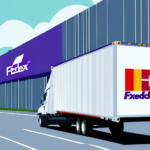How to Use Bundling Shipments to Negotiate Better Shipping Rates with UPS
In today’s competitive business environment, managing costs is essential to the success of any company. One area where companies can make significant savings is in shipping. Shipping can be a significant operational expense, but there are ways to lower costs, such as through bundling shipments with UPS. Read on to learn how to use bundling shipments to negotiate better shipping rates with UPS.
Understanding Bundling Shipments and their Benefits
Bundling shipments involves consolidating multiple orders into one shipment. This process helps businesses to save on freight costs as it eliminates the need for multiple small shipments. By combining shipments, companies can negotiate better rates, as carriers prefer larger shipments. Moreover, bundling shipments can streamline the delivery process, reducing the need for additional transportation costs.
Another benefit of bundling shipments is that it can help companies to reduce their carbon footprint by cutting down on the number of deliveries.
In addition to cost savings and environmental benefits, bundling shipments can also improve inventory management. By consolidating orders, businesses can better track their inventory levels and avoid overstocking or understocking. This can lead to more efficient use of warehouse space and reduced storage costs.
Furthermore, bundling shipments can enhance customer satisfaction by providing more accurate and reliable delivery times. With fewer shipments to manage, companies can better predict delivery times and provide customers with more accurate tracking information. This can lead to increased customer loyalty and repeat business.
Tips for Choosing the Right Bundling Strategy for Your Business
Choosing the right bundling strategy is critical to realizing the cost-saving benefits of this approach. One common strategy is to bundle items from the same customer or region and consolidate them into one shipment. Another approach is to bundle orders that have similar dimensional characteristics.
It is also essential to consider the shipping destinations and modes of transportation. Companies operating across national borders may need to follow specific customs requirements, which may affect their bundling strategy. Incorporating these considerations into the bundling process can help to maximize its cost-saving benefits.
Another important factor to consider when choosing a bundling strategy is the type of products being shipped. Some products may require special handling or packaging, which can affect the bundling process. For example, fragile items may need to be packaged separately to prevent damage during transit.
Finally, it is important to regularly review and adjust your bundling strategy as your business evolves. Changes in customer demand, product offerings, or shipping requirements may require a different bundling approach to maintain cost savings and efficiency.
How to Calculate Shipping Costs for Bundled Shipments
Calculating shipping costs for bundled shipments is essential to determine the savings offered by this approach. The cost of shipping is dependent on the weight, size, and destination of the shipment. To determine the most cost-effective bundling option, businesses need to calculate the total volume and weight of the items and estimate the shipping costs for each.
Companies can also use shipping cost calculators to get an estimate of the shipping costs for their bundled shipments. Furthermore, some shipping services offer volume discounts and other incentives, which can further reduce the overall shipping costs for companies.
It is important to note that while bundling shipments can lead to cost savings, it may also result in longer delivery times. This is because the shipping carrier may need to wait until all items in the bundle are available before shipping them out. Therefore, businesses should consider the urgency of their shipments and weigh the cost savings against the potential delay in delivery when deciding whether to bundle their shipments.
Negotiating with UPS: Tips and Tricks for Getting the Best Deals
Negotiating with UPS is a crucial step in ensuring that businesses get the best deals on shipping rates. Here are some tips and tricks for successful negotiations:
- Do your research on the industry rates and compare them to UPS rates.
- Identify key negotiation points, such as payment terms, delivery times, and discounts.
- Build a relationship with your UPS representative to gain better insights into their pricing structures and policies.
- Be prepared to negotiate for better terms and rates.
- Consider bundling shipments to increase leverage during negotiations.
Another important factor to consider when negotiating with UPS is volume. The more shipments you have, the more negotiating power you have. If you have a high volume of shipments, you may be able to negotiate lower rates or better terms.
It's also important to be flexible in your negotiations. If UPS is unable to meet your demands on one aspect of the negotiation, be open to finding a compromise or alternative solution. This can help build a positive relationship with your UPS representative and lead to better deals in the future.
How to Build Strong Relationships with Your UPS Representatives
Building strong relationships with UPS representatives is essential to successful negotiations, and it can also help businesses stay informed about industry trends, new technologies, and policy changes. Here are some tips for building strong relationships:
- Communicate regularly with your UPS representatives through email, phone, or in-person meetings.
- Stay up-to-date with industry news and trends to have informed conversations.
- Be clear about your business needs and expectations, and work collaboratively with your representative to find the best solutions.
- Provide feedback on their services and respond positively to their feedback to foster a healthy partnership.
Another important aspect of building strong relationships with UPS representatives is to understand their roles and responsibilities within the company. Each representative may have different areas of expertise and knowledge, so it's important to identify who can best assist with specific needs or concerns. Additionally, taking the time to learn about the company's policies and procedures can help streamline communication and ensure that both parties are on the same page. By building a strong relationship with your UPS representative, you can create a mutually beneficial partnership that can help your business thrive.
Common Mistakes to Avoid When Negotiating Shipping Rates
While negotiating with UPS can be effective in securing cost savings, businesses need to be aware of common mistakes to avoid during negotiations. These include:
- Not being prepared and informed about industry rates and market trends.
- Overestimating your bargaining power and pricing expectations.
- Not considering alternative shipping options or providers.
- Being too rigid in your demands and unwilling to compromise.
- Failing to build a strong relationship with your representative.
One additional mistake to avoid when negotiating shipping rates is not taking into account the volume of shipments. Businesses that ship large volumes may be eligible for volume discounts, which can significantly reduce shipping costs. It is important to have a clear understanding of your shipping volume and to communicate this to your representative during negotiations.
Another mistake to avoid is not reviewing your shipping invoices regularly. Shipping rates can change frequently, and it is important to ensure that you are being charged the correct rates. By reviewing your invoices regularly, you can identify any discrepancies and address them with your representative, potentially saving your business money in the long run.
The Role of Technology in Optimizing Your Shipping Strategies
Technology plays a significant role in optimizing shipping strategies. Investing in shipping software and tools can help businesses automate shipping processes, generate cost-saving opportunities, and increase visibility into shipping performance. Here are some examples of technology solutions for shipping optimization:
- Transportation management systems (TMS) for managing shipping logistics and reducing shipping costs.
- Freight audit and payment services to ensure accurate and timely billing.
- Inventory management systems to track inventory levels and automate order fulfillment processes.
- Shipping analytics tools to provide insights into shipping performance and inform strategic decision-making.
Analyzing Data to Identify Areas for Improvement in Your Shipping Processes
Analyzing shipping data can provide valuable insights into areas for improvement in your shipping processes. To begin data analysis, businesses should gather data on their shipping volumes, costs, delivery times, and other shipping metrics. They can then use this data to identify opportunities for improvement, including:
- Identifying cost-saving opportunities through bundling shipments, optimizing shipping routes and modes of transportation.
- Improving delivery times and reducing shipping lead times.
- Streamlining order fulfillment processes and reducing shipping errors.
- Reducing environmental impact by minimizing carbon emissions.
Leveraging Other Carrier Services to Enhance Your Shipping Options
While UPS is a popular carrier for shipping, businesses can leverage other carrier services to enhance their shipping options and reduce costs. Other carriers offer different pricing structures and shipping service levels that may be better suited for certain types of shipments. Here are some examples of other carrier services:
- FedEx: Offers expedited shipping services for urgent deliveries.
- DHL: Specializes in international shipping services.
- USPS: Offers cost-effective shipping options for small packages and mail.
Ensuring Compliance with UPS Policies and Regulations
Finally, it is essential to ensure that businesses comply with UPS policies and regulations to avoid any penalties or compliance issues. UPS has strict regulations regarding the shipment of hazardous materials, perishable items, and other types of goods. Compliance with these regulations can minimize shipping risks and maintain healthy business relationships with UPS.
Best Practices for Managing Inventory and Fulfillment Operations
Lastly, managing inventory and fulfillment operations is critical to the success of any business, including managing shipping costs. Here are some best practices for managing inventory and fulfillment operations:
- Invest in inventory management software to gain better visibility into your inventory levels and reduce stockouts.
- Use data analysis to optimize your inventory levels and reduce excess inventory.
- Maintain accurate product information and pricing to ensure accurate order fulfillment and shipping.
- Implement quality control measures to prevent shipping errors and damages.
Case Studies: Successful Businesses that Have Mastered Bundling Shipments with UPS
Finally, here are some case studies of businesses that have successfully mastered bundling shipments with UPS and realized significant cost savings:
- ArtsCase: A smartphone case retailer that saved 60% on shipping costs by consolidating orders into one shipment.
- Akron Hardware: A hardware supplier that saved over $250,000 annually by bundling shipments and negotiating with UPS for better rates.
- LeatherBound: A leather goods retailer that saved up to 30% on shipping costs by bundling orders and choosing the most cost-effective shipping options.
By following the tips and best practices outlined in this guide, businesses can effectively use bundling shipments to reduce shipping costs and negotiate better rates with UPS.








